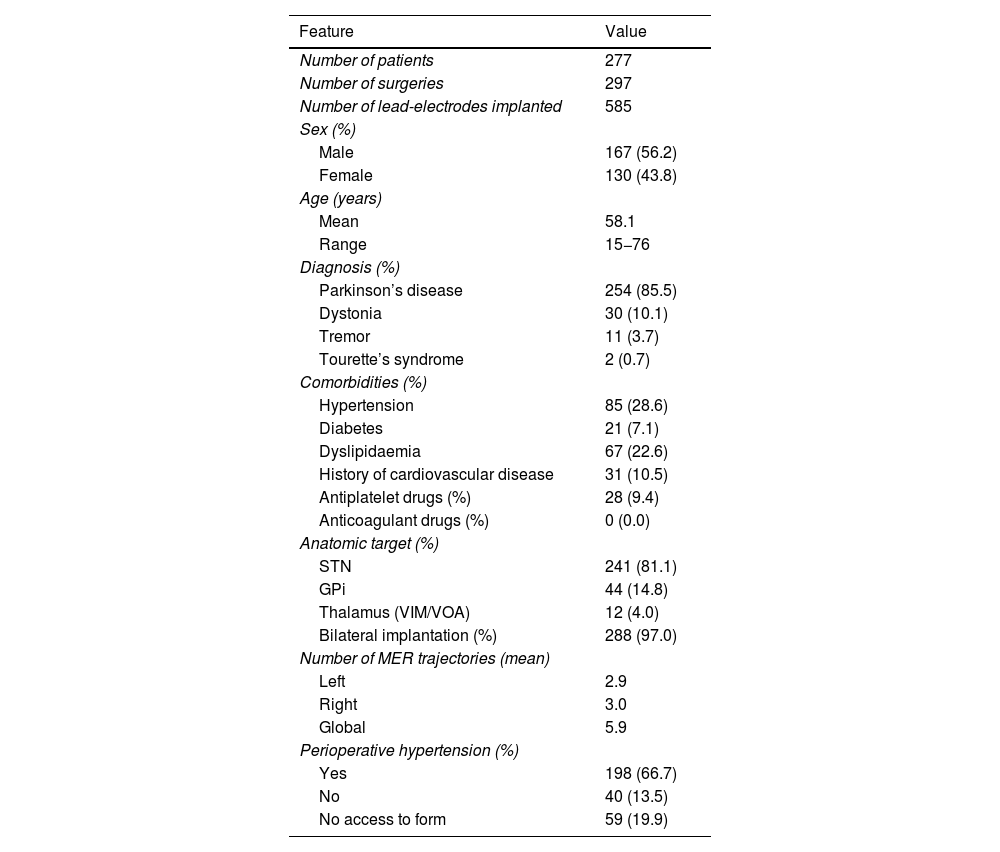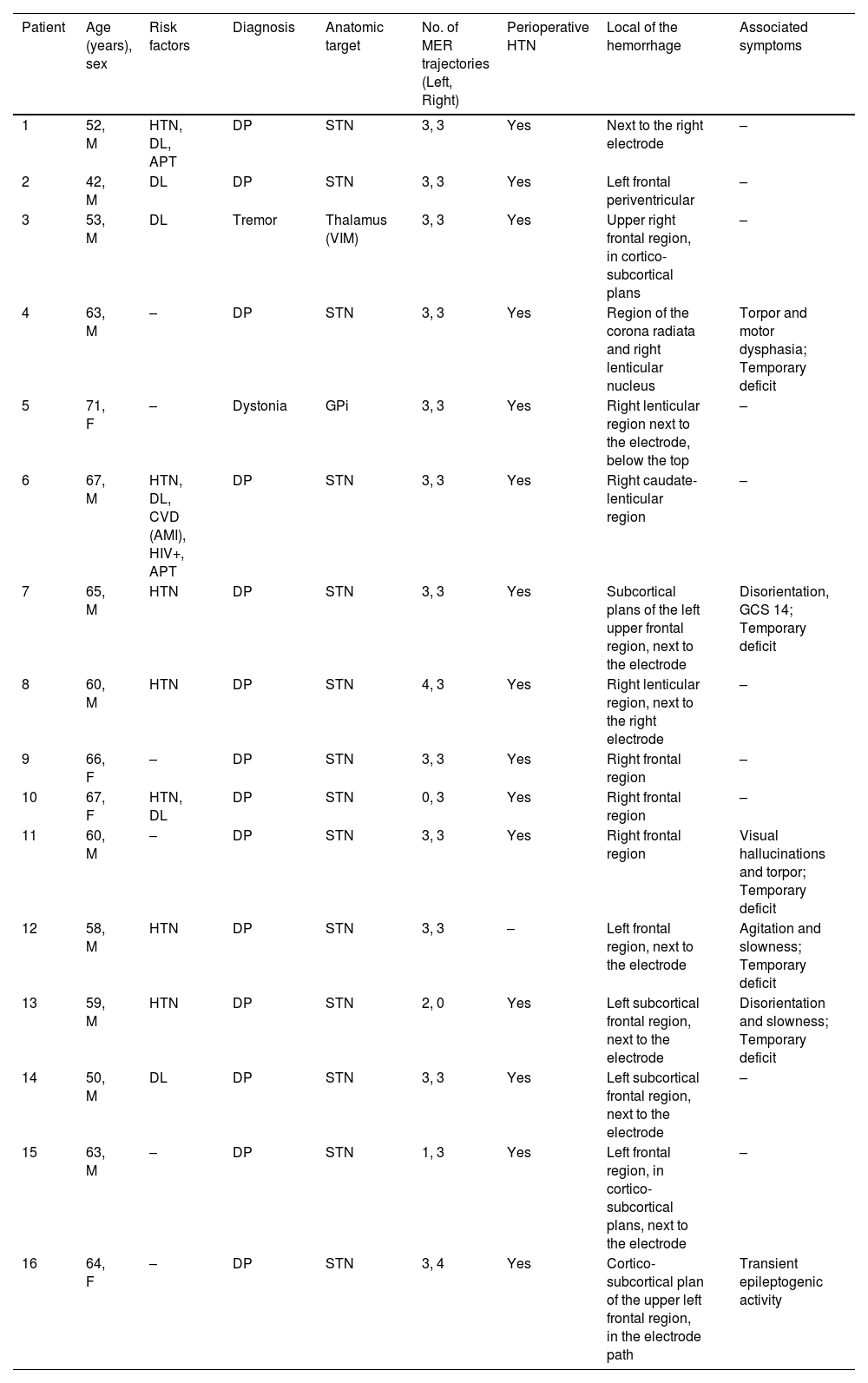Report the incidence of symptomatic and asymptomatic intracerebral hemorrhage (ICH) in patients submitted to deep brain stimulation (DBS) guided with microelectrode recording (MER) with further analysis of potential risk factors, both inherent to the patient and related to the pathology and surgical technique.
MethodsWe performed a retrospective observational study. 297 DBS procedures were concluded in 277 patients in a single hospital centre between January 2010 and December 2020. All surgeries were guided with MER. We analysed the incidence of symptomatic and asymptomatic ICH and its correlation to age, sex, diagnosis, hypertension and perioperative hypertension, diabetes, dyslipidaemia, antiplatelet drugs, anatomic target, and number of MER trajectories.
ResultsThere were a total of 585 electrodes implanted in 277 patients. 16 ICH were observed, of which 6 were symptomatic and 10 asymptomatic, none of which incurred in permanent neurological deficit. The location of the hemorrhage varied between cortical and subcortical plans, always in relation with the trajectory or the final position of the electrode. The incidence of symptomatic ICH per lead-implantation was 1%, and the CT-scan demonstrated asymptomatic ICH in 1.7% more patients. Male patients or with hypertension are 2.7 and 2.2 times more likely to develop ICH, respectively. However, none of these characteristics has been shown to have a statistically significant association with the occurrence of ICH, as well as age, diagnosis, diabetes, dyslipidaemia, antiplatelet drugs, anatomic target, number of MER trajectories and perioperative hypertension.
ConclusionsMER-guided DBS is a safe technique, with low incidence of ICH and no permanent deficits in our study. Hypertension and male sex seem to be risk factors for the development of ICH in this surgery. Nevertheless, no statistically significant factors were found for the occurrence of this complication.
Reportar la incidencia de hemorragia intracerebral (HIC) sintomática y asintomática en pacientes sometidos a estimulación cerebral profunda (ECP) guiada por microrregistro (MER), con el consecuente análisis de posibles factores de riesgo, tanto inherentes al paciente como relacionados con la patología y técnica quirúrgica.
MétodosRealizamos un estudio observacional retrospectivo. Se analizaron un total de 297 procedimientos de ECP realizados en 277 pacientes en un centro hospitalario entre enero de 2010 y diciembre de 2020. Todas las cirugías fueron guiadas con MER. Analizamos la incidencia de HIC, tanto sintomática como asintomática, y la correlación con edad, sexo, diagnóstico, hipertensión arterial e intraoperatoria, diabetes, dislipemia, medicación antiplaquetaria previa, diana anatómica y número de vías.
ResultadosEl número total de electrodos implantados fue de 585 en 277 pacientes. Se observaron 16 HIC, de las cuales 10 fueron asintomáticas y 6 sintomáticas y ninguna incurrió en déficit neurológico permanente. La localización de la hemorragia varió entre planos corticales y subcorticales, siempre en relación con el trayecto o posición final del electrodo. La incidencia de hemorragia sintomática fue de alrededor del 1 %, y la TC posoperatoria demostró hemorragia asintomática en un 1,7 % adicional de los pacientes. Los pacientes varones o los pacientes con hipertensión tienen 2,7 y 2,2 veces más probabilidades de desarrollar sangrado, respectivamente. Sin embargo, ninguna de estas características demostró una asociación estadísticamente significativa con la ocurrencia de hemorragia intracerebral, como la edad, el diagnóstico, la diabetes, la dislipidemia, la ingesta previa de medicamentos antiplaquetarios, el objetivo anatómico, el número de MER y las vías de HTA intraoperatorias.
ConclusiónLa ECP con MER es una técnica segura, con baja incidencia de HIC y sin déficits permanentes en nuestro estudio. La hipertensión arterial y el género masculino parecen ser factores de riesgo para el desarrollo de HIC en esta cirugía. Sin embargo, no se encontraron factores estadísticamente significativos para el aumento en la ocurrencia de esta complicación.
Article

If it is the first time you have accessed you can obtain your credentials by contacting Elsevier Spain in suscripciones@elsevier.com or by calling our Customer Service at902 88 87 40 if you are calling from Spain or at +34 932 418 800 (from 9 to 18h., GMT + 1) if you are calling outside of Spain.
If you already have your login data, please click here .
If you have forgotten your password you can you can recover it by clicking here and selecting the option ¿I have forgotten my password¿.









